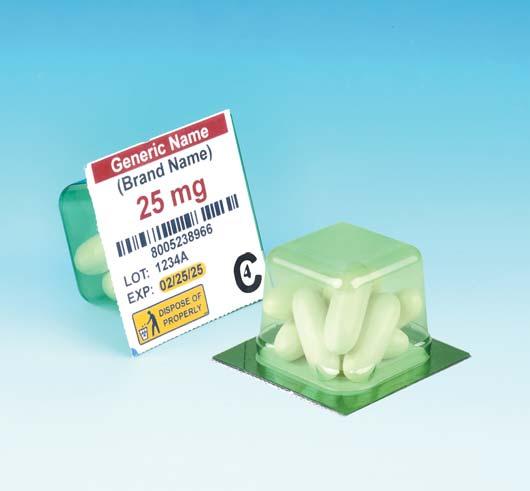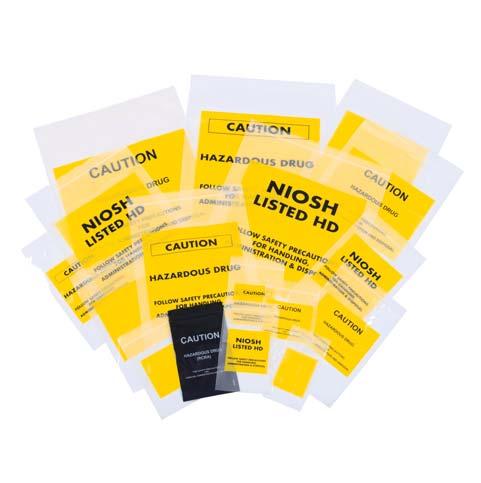
20 minute read
TECHNOLOGY
COVID-19 Prompts a Second Look at CSTDs
In April, with COVID-19 cases increasing nationally, Cone Health oncology services in Greensboro, N.C., took a fresh look at closed system drugtransfer devices (CSTDs).
The service, which operates five cancer care centers across the state’s North Central Piedmont region—with a sixth center slated to open in September 2021—had been tasked along with other Cone Health services to find ways to bolster operational effectiveness in light of the pandemic’s potential threat to health-system operations.
Cone Health was not within an epicenter of coronavirus infections at that point, but organizational concern was rising over the likely revenue impact of a COVID-19 patient surge and about people losing health insurance and income due to local business closings. The aim A pharmacy technician compounds a hazardous medication using the BD PhaSeal was to get ahead of a possible crashing Optima closed system drug transfer device. USP <800> requires CSTDs for administerwave with a lean approach to costs, par- ing antineoplastic compounds, but “recommends” the devices in preparing the drugs. ticularly of consumables.
Medication use was an obvious target. with disposable CSTDs and IV infusion following weeks was similar to ones that “Drug costs were a huge driver, one of the bags and lines. other integrated health networks have inilargest cost centers out there,” said Andre Until April, the oncology clinics had tiated to comply with USP General ChapD. Harvin, PharmD, the director of phar- been using BD’s PhaSeal CSTD system. ter <800>, which took effect in December. macy oncology. For Cone Health’s can- “When COVID-19 hit, we saw it as an Budget dollars have typically played cer care clinics, which treat some 3,800 opportunity to sit down and say, ‘This is an outsized role in these discussions, to 4,200 patients each year, medication one of our more expensive consumables,’” said Patricia C. Kienle, RPh, MPA, the use also meant the hefty costs associated Harvin said. “Should we reevaluate?” The director of accreditation and medication with preparing and administering anti- answer was yes. safety for Cardinal Health. “If money neoplastics, including those associated The assessment that took place over the wasn’t the issue, nobody would be talking about this. We’d all be doing it. “But people need to be safe,” added
Chemotherapy Robots an Aid Kienle, who is also a member of the USP Compounding Expert Committee.
In High Volume “So USP <800> requires CSTD use for administration of Table 1 antineoplasL ike many other health systems with high-volume oncology clinics, Cone Health centers employ robots and other automation tics when the dosage form allows.” (It also “recommends” use of the device in preparing the drugs.) technology to increase productivity Kienle also noted that “the vast majorand dose accuracy while further ity” of people she had spoken to had shielding technicians from harmful already acted to implement the USP chemotherapy exposure. employee safety standards (surveys of
Two of the health system’s health systems support that). “There’s largest clinics, at Wesley Long Hospital, in Greensboro, N.C., and Alamance Regional Medical some utility for using [CSTDs] for other drugs, but that’s up to individual organi-
Center, in Burlington, N.C., deploy zations to look at what works for them.”
APOTECAchemo robots (Apoteca Kienle added that vetting the merits
USA, an affiliate of Italy’s Loccioni and potential weaknesses of prospective industrial engineering company) CSTDs should not be done indepento automate compounding of most hazardous drugs. Cone Health’s other clinics are equipped with APOTECAps, a guided automated system that uses gravimetrics to weight dose ingredients and ensure compounding accuracy. An inside look at the Apoteca Chemo robot as it performs a manipulation of a hazardous medication. The platform uses barcode scanning, gravimetrics and a sterile environment to perform its compounding independently. dently by either pharmacy or nursing. “This is a team sport,” she stressed. “It needs to be coordinated in a system, and it cannot just be the cheapest one on the buying group contract.”
“Everything we compound we Coordination Is Key try to push through gravimetrics, whether hazardous or nonhazardous,” said Andre D. Harvin, PharmD, BCPS, the director of pharmacy oncology at Cone Health, in Greensboro. “We are actually in the midst of expanding At Cone Health, team coordination was central to an evaluation that led to the [APOTECAps] because we don’t have it in every hood.” deployment of a new CSTD system at the
Other compounding automation companies competing in the same space end of May. The investigation included include Equashield, Grifols’ Kiro Oncology and Omnicell. virtual presentations from device mak—B.B. ers, including BD, that were asked to demonstrate, via Zoom, what made their

6 Steps For Vendor Evaluation
Most health systems have already integrated closed system drugtransfer devices (CSTDs) into their compounding and administration processes. But for those still weighing their options, Fred Massoomi, PharmD, a senior director at the pharmacy consulting firm Visante, offered six steps to aid in decision making.
1Look at the FDA 510(k)
clearance document. The idea is to see what the device was approved for and what information was submitted to the FDA to obtain clearance. It will provide a good understanding of the thoughts behind the device and how and why it was developed.
2Go to company websites. These can be great resources for educational materials, as well as information on the size of the product portfolio for the device. If it has just a few pieces, it may not meet all of your needs.
3Schedule a visit. If a candidate looks promising, spend time with a company representative, virtually if need be. The meeting needs to cover detailed information on the device and how it would work within your compounding and administration workflow.
4Ask for a brief trial run. This is to allow pharmacists, technicians and nurses to see how well the device performs within your system. It really depends on your setup: how you use your primary engineering controls to move hazardous drugs through the compounding process and how well the device fits into nurses’ administration environment.
5Ask additional questions about materials used in making the
device. Find out how the device was tested to demonstrate conformance with National Institute for Occupational Safety and Health standards for preventing toxic emissions and pathogenic ingress. Has it been tested on the drugs that will be used with the device to ensure compatibility, and will there be any leaching or other issues that can occur with certain drugs?
6Review all the materials sent to the FDA for clearance of the
CSTD. This includes 510(k) letter, marketing clearance statements, comparative studies to the predicate devices, etc. —B.B.
CSTDs safer and easier to use—and to relate how much educational and other support would be forthcoming. Price was another consideration.
Harvin said he also called peers at
Dose Round
continued from page 1
In this prospective study, the researchers selected 24 high-cost and frequently used infusion drugs and created standardized dose-rounding rules that they then integrated into the Epic EMR system (abstract PM01). Any dose of these drugs calculated to be within 10% of the nearest vial size was automatically adjusted up or down to the nearest full vial, said Katie Eschenburg, PharmD, an infusion pharmacist at the Rogel Cancer Center at Michigan Medicine and a coauthor of the study.
Physicians would then review the rounded dose to ensure they agreed with the rounding plan, and could opt out, if needed, Hough said.
The 10% value was chosen based on HOPA guidance on dose rounding, which suggests adjusting the dose of many oncology drugs by 5% to 10% is unlikely to have a clinical effect. However, the effect of rounding on patients has not been well studied, Hough noted.
From July 1, 2018 to June 30, 2019, more than 10,200 doses of the selected drugs were administered at Michigan Medicine, most patients in outpatient clinics. Half of the administered doses were rounded to the nearest vial size; of these, about 50% were rounded up and about 50% were rounded down, said Jacqueline Dela Pena, PharmD, a PGY-1 pharmacy practice resident at Michigan Medicine and co-author on the study. other oncology organizations to hear about their experiences with CSTDs, including device failures, because, he noted, “these things happen.” But perhaps the most important input came from Cone Health’s end users themselves: the technicians and nurses.
In the end, the nod went to BD’s Optima PhaSeal CSTD. It wasn’t that the other devices that were evaluated didn’t provide a high degree of compounding and administration safety; they did. The deciding factor, Harvin noted, was technicians’ and nurses’ comfort level based on their familiarity with PhaSeal and BD’s support system. He added that the newer Optima PhaSeal CSTD now uses a straight push-and-click action to connect with IV lines rather than the older device’s push-and-twist manipulation, which had prompted some complaints about repetitive motions needed to line up the red lines indicating secure connections.
“We had to go through these evaluations very quickly,” Harvin said. “We went live with the new Optima PhaSeal system clinic by clinic, making sure each was ready to go. We saved the largest clinic here at Wesley Long Hospital for last. Everything was done by the end of May.”



In all, the rounded doses led to about $3.5 million in savings on outpatient infusions and $130,000 in savings on inpatient infusions, resulting in about $3.6 million saved overall, Dela Pena said. The drugs associated with the highest annual savings were trastuzumab, which accounted for $756,000 in savings, and ipilimumab (Yervoy, Bristol-Myers Squibb), which accounted for $494,000 in savings.
The study assumed the pharmacy used the smallest number of vials to fill each order, and there weren’t any dosing errors, Dela Pena said. It would have been extremely labor-intensive to review all 10,000-plus doses for inefficient vial use, but it’s also unlikely the pharmacy was 100% efficient, which could affect final cost savings, Hough noted.
Dose rounding in and of itself is not a new idea, commented HOPA President David DeRemer, PharmD, the assistant director of clinical therapeutics at UF Health Cancer Center, in Gainesville, Fla. But automating the process is unique, said
Ryan Forrey, PharmD, the senior manager of Market Development for Hazardous Drugs at BD, said several factors need to be considered when selecting a CSTD. “From a clinical perspective, the things I think about are evaluating safety and performance of the CSTD as well as the ergonomics and ease of use, as well as the history and experience others have had with CSTDs.” What’s more, Forrey said, it’s not just the CSTD itself that needs to be evaluated. “There is monitoring and understanding your environmental conditions. Can your device manufacturer help with that?”
He added: “How good are they in installing and implementing the device? You can have the best device in the world, but if you can’t implement it or train people and teach them how to use it, you’re not going to be successful.” —Bruce Buckley DeRemer, who was not involved with the study. “The integration of automatic dose rounding, within 10% of the original dose, into the electronic ordering system provides the opportunity for drug savings as well as reducing medication errors.”
Automating the system removed all the back-end labor for the pharmacist because everything is integrated into the EHR, Dela Pena said.
Because the system proved so successful, the project is ongoing and the researchers are testing other oncology agents to add to the rounding protocol, she said, adding that the team also is looking to implement dose-rounding beyond oncology drugs to other high-cost therapies, such as rheumatoid arthritis agents.
Hough, Dela Pena and Eschenburg plan to submit their study for publication. They said they hope this protocol could eventually help other institutions implement similar automatic systems and reap the cost savings.
“I think the big key takeaways about this project are that a little up-front work on dose-rounding rules can be implemented into an EHR,” Hough said. “If institutions don’t have the ability to roll this out across all oncology medications, a review of the top 10 or 20 in the drug spend can still yield a very significant savings.”
The sources reported no relevant fi nancial relationships.
Training Support Is Key
—Jillian Mock

Massoomi reported he is a consultant for BD. Kienle reported she is a member of the USP Expert Compounding Committee; the views she expressed for this article are her own. The remaining sources reported no relevant fi nancial relationships beyond their stated employment.

ADC optimization, data mining among keys to success
Getting a Handle on Drug Inventory During COVID-19
The surge in demand for sedatives and other medications brought on by the peak of the COVID-19 pandemic presents lessons that pharmacists can learn for better drug inventory management, pharmacists said during a recent webinar sponsored by BD.
The pandemic “has certainly challenged our society and health care system m in many ways, even in geographic areas that frequently manage e natural disasters, such as fires or hurricanes, and have very experienced disaster managers,” said Doina Dumitru, PharmD, MBA, the senior director of medical affairs for BD, during a discussion on managing drug inventory during a pandemic. “The current crisis requires a new set of rules and playbooks.”
One of the most serious issues to emerge has been employee safety, Dumitru said, which can be enhanced by limiting traffic in and out of facilities, including the pharmacy. During normal operations, pharmacy staff touch their drug inventory at least once a day whether ordering, refilling or other tasks, she said. During a pandemic, the safety strategy of reducing the number of trips to automated dispensing cabinets by increasing inventory of critical medicines limits staff exposure to highrisk areas of the hospital.
In addition, Dumitru said, in a pandemic, supply needs can change very quickly—sometimes within hours. As facilities become overwhelmed with high-acuity patients requiring many interventions, items such as swabs, IV i lines and drugs can be depleted very quickly. So it’s important to keep a concise list of those critical supplies, she advised, and take inventory at least daily, if not more often. It also may be necessary to adjust par levels up for those drugs and supplies proactively, because historical par levels won’t be sufficient to meet the anticipated surge, she said. Some organizations reported four- to fivefold increases on inventory run rates for supplies. Finally, Dumitru said, leverage recent regulatory allowances to maximize all drug supplies on hand, such as centralizing some sterile compounding and distribution activities.
Preplanning also can be helpful for pandemics when there is time, said W. Perry Flowers, RPh, MS, the vice president of medical affairs and Enterprise Medication Management for BD. “We [were fortunate] with this particular
Strategies for Managing Shortages During a Pandemic
• Recognize that first-line therapy items might be in short supply and could be exhausted, and go to your pharmacy and therapeutics committee with recommended protocols and at least two approvable, substitutable items.
This will include your first, second and third lines of therapy for antibiotics and antivirals. • Prepare to switch alternative therapies quickly, as usual therapies are depleted rapidly. • All alternatives should have usage guidelines, and information technology staff should be able to update drug libraries and order sets quickly as alternative drugs are stocked. • Clinicians such as physicians and nurses should be trained on how to order and administer alternative therapies. • Be prepared for large quantities of IV infusions, and adjust dosage form volumes accordingly. Larger bags of certain drugs, particularly those for sedation, will likely be needed. This allows nurses to limit the number of bag changes needed for these medications. • Calculate drug inventory at least daily, if not more often. Leverage any technology solutions your vendors may offer to allow par level changes to be made for automated dispensing cabinet. • Use all data available to create forecasts and projections for supplies; it’s one of the most powerful strategies in ensuring continuity of care for patients.


—Erin R. Fox, PharmD
pandemic to have a little bit of forewarning as to what might be coming,” Flowers said. Studying data from China, or New York’s response, for example, can give hospital leadership some clues what to expect, as can using data that can serve as a proxy for expected demand, such as reviewing statistics from the CDC comparing COVID-19–like illness to influenza-like illness and the percentage of related emergency department visits, to help with emergency preparedness.
Overall, during COVID-19 surges, many hospitals ran low on supplies, not only medications and ventilators but items for supportive care, such as antiseptic mouth rinse for ventilated patients, Dumitru noted. By examining those shortages, a number of valuable lessons can be gleaned (sidebar).
A Different Kind of Shortage
The pandemic presented an unusual situation with drug shortages due to a spike in demand, as opposed to those caused by manufacturing delays or other more common issues, commented Erin R. Fox, PharmD, BCPS, the senior pharmacy director of Drug Information and Support Services at the University of Utah Health, in Salt Lake City.
“Usually a shortage is a really bad surprise, and you don’t have a lot of advance warning,” Fox said. “In this case, you could see the tsunami coming, but you may not have been prepared for it or you just did the best you could and hoped you were prepared for it.”
It can be a knee-jerk reaction to try to order six months’ worth of all medications, she added. But consider where you would store that much, and whether you really need it or are taking it from other hospitals that are in greater need. “I’m so grateful that the entire country didn’t surge at one time, because while New York and other hot spots needed a big spike in medications, other places like our state didn’t need as much. Now, unfortunately, it may be the reverse.”
Try to prepare, and be data-driven if you can, she advised. Tally up your hospital’s preferred drugs, think about what your daily dose would be, and make calculations from there. Consider you may have limits in what you can order or what you can store. Work together as a team within your hospital to share resources. For example, her hospital’s anesthesia department was willing to make some changes to their practice to conserve propofol for the ICUs.
The pandemic was made challenging by the many products that hospitals need, such as midazolam and fentanyl and some paralytics; some saw supply chain issues before the pandemic, Fox said. Another challenge has been in updating informatics systems to account for different dosage forms or strengths. During a previous morphine shortage when her hospital switched from syringes to vials, it took an estimated 100 hours of informatics work to make the changes, she said.
To access a replay of the webinar, see bit.ly/2J9b6TJ. —Karen Blum
Health-system specialty pharmacies:
Lots of Data, but What Do Payors Want to Know?
Although health-system specialty pharmacies have access to an abundance of clinical and dispensing data, according to an expert who spoke during a session at the 2020 NASP Annual Meeting & Expo Virtual Experience, some pharmacies in outcomes-based contracts continue to ask payors the same question: What outcomes do they want to know about?
That’s the “million-dollar question,” Bryan Schuessler, PharmD, MS, the director of home infusion and specialty pharmacy at Saint Luke’s Health System Kansas City, in Missouri, said during the session, a one-day pre-conference workshop on health-system specialty pharmacy. “What is it that people really want to see on that payor line? We’re not sure from payor to payor what’s valuable at this point.”
Many other health-system specialty pharmacies that are drawing up outcomes-based contracts are likely to be in the same boat, finding that payors do not always know what outcomes they want to have measured as part of a the NASP 2020 Annual Meeting & Expo Virtual Experience had a clear message for specialty pharmacies, whether embedded in health systems or stand-alone: We want your data.
One presenter said data collected through prior authorizations, for example, can help manufacturers understand why some prescriptions are left unfilled.
“Perhaps the diagnosis isn’t correct,” said Cheryl Allen, the principal consultant at Blue Fin Group. “Or maybe there’s a lack of education among the prescribers on the use of the drug.”
In those cases, manufacturers can tailor their physician communication to ensure the drug is prescribed appropriately, Allen said. “The more we know about our patient’s journey, the better we are positioned to support them.”
Any information that manufacturers can use to improve their grasp of the barriers that exist to medication use or prescription fulfillment “is really critical,” agreed Jenny Jackson, the head of strategy, specialty and strategic markets at UCB Pharmaceuticals, in Kansas City. “Without actionable data, you really lack the ability to

contract, Schuessler said. “Is a clinical outcome SVR [sustained virologic response] or is it days-to-therapy, or is it adherence?” he asked.
Schuessler noted that his team draws on a large pool of data from the Saint Luke’s electronic health record system as well as dispensing and clinical documentation data from their retail and specialty pharmacies. “We’re documenting all these things. We’re following patients. We’re making notes. We’re collecting all these data, but … we’re still struggling to understand what [payors] want to see,” he said.
At West Virginia University Hospitals, in pivot or course-correct as necessary,” she said. “I can’t stress enough the value of that collaborative approach” between manufacturers and specialty pharmacies.
Payors, too, place a premium on the data that specialty pharmacies gather, as Ryan Atkinson, PharmD, the senior director of specialty pharmacy strategy at Maxor National Pharmacy Services, a pharmacy benefit manager, said. While Maxor has a separate specialty pharmacy arm, the company’s two sides often work “synergistically,” he said.
For example, Atkinson said the PBM uses data analytics to develop algorithms “that can identify specific trends in how a patient is taking their medications, when they’re getting their refills, and even relate it to their age, in some cases to their overall disease state, or to some of their comorbidities.”
Those algorithms can help direct patients to clinical programs to optimize the safety and efficacy of a medication, he explained. —David Wild Morgantown, a lack of payor clarity on the question of outcomes led Louis Sokos, BS Pharm, MBA, the director of allied health solutions, specialty pharmacy services, to formulate what he believes is a universally applicable equation. Specifically, he said, demonstrating the impact of specialty pharmacies on both clinical outcomes and total cost of care for the health system is “a value proposition that I think any payor can see.”
He stressed that health-system specialty providers have “to make sure we manage our patients as efficiently as we can and drive down costs overall … to make sure we’re a player in this space.” For example, his specialty pharmacy looked at a group of the health system’s patients receiving antiviral medications and documented SVR rates that were higher than those of most nearby pharmacies outside their system, showing “a better return on investment” for payors, he said.
Other health-system specialty pharmacies should take similar initiative and articulate what they believe to be the value of their services, suggested session moderator Erin Hendrick, the senior vice president of hospital strategy at Shields Health Solutions, headquartered in Stoughton, Mass. “We seem to have, as a collective, been very reactive to the data that’s been requested of us,” she said. Instead, Hendrick said, “I think there’s an opportunity for health systems to better define what we believe good specialty outcomes really are.”
The sources reported no relevant fi nancial relationships.
Specialty Pharmacies Offer Valuable Data to Stakeholders
Arange of stakeholders speaking at
—David Wild






